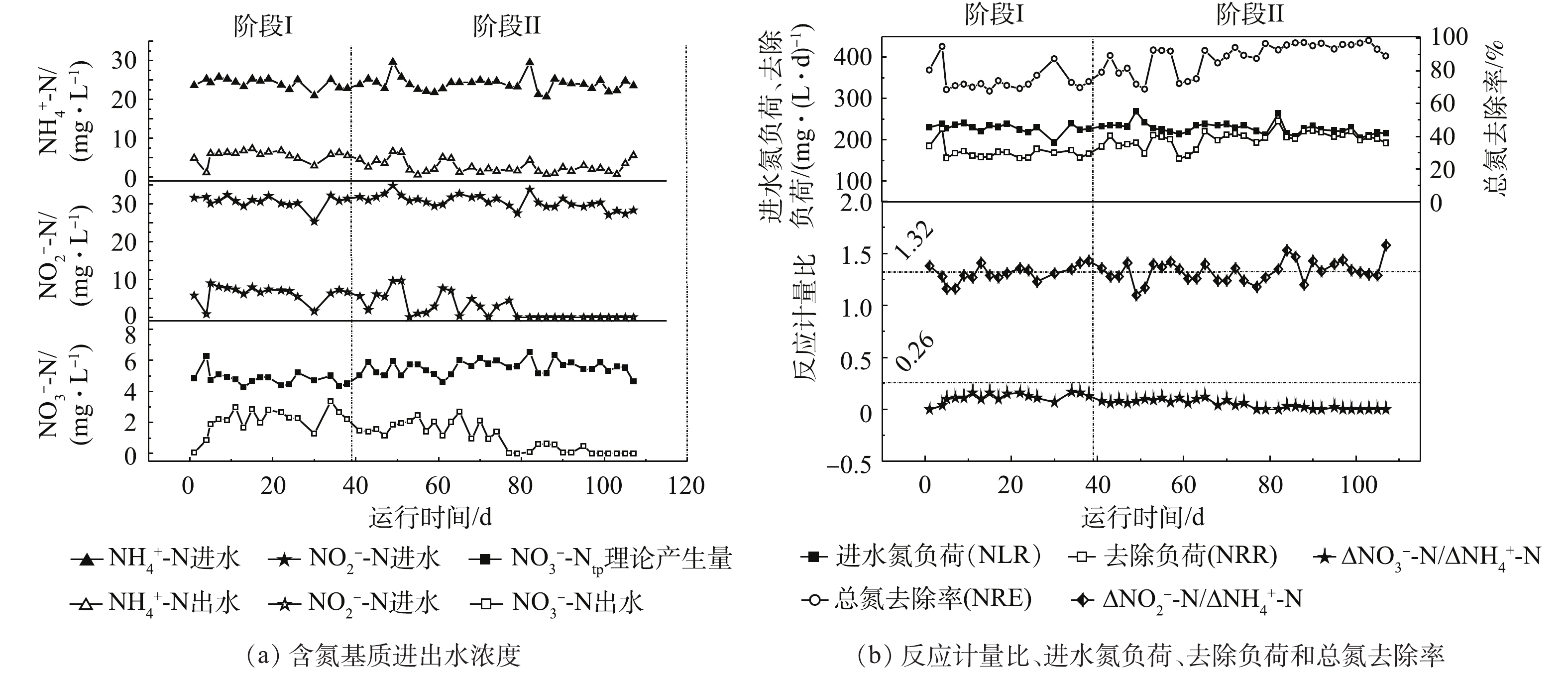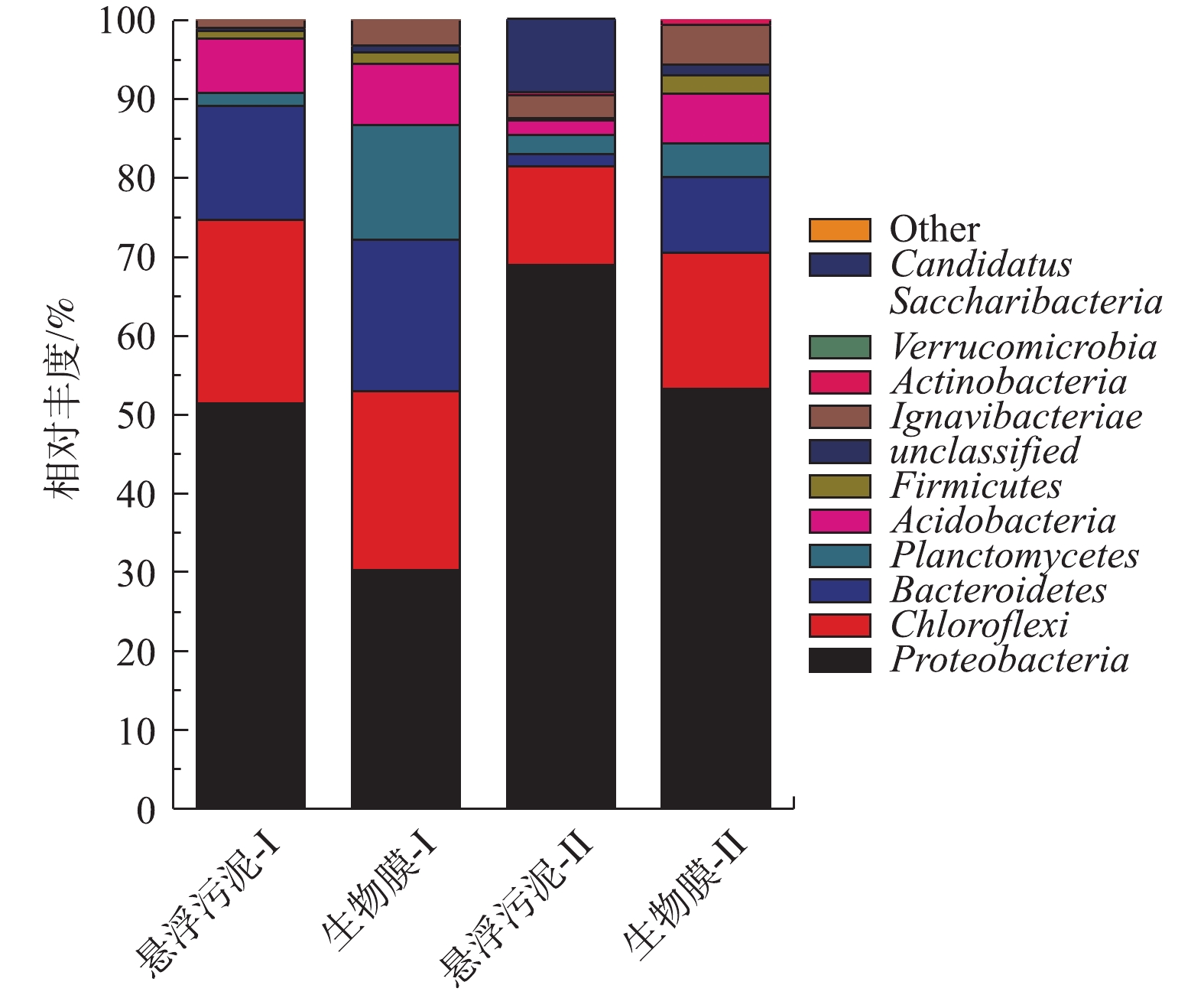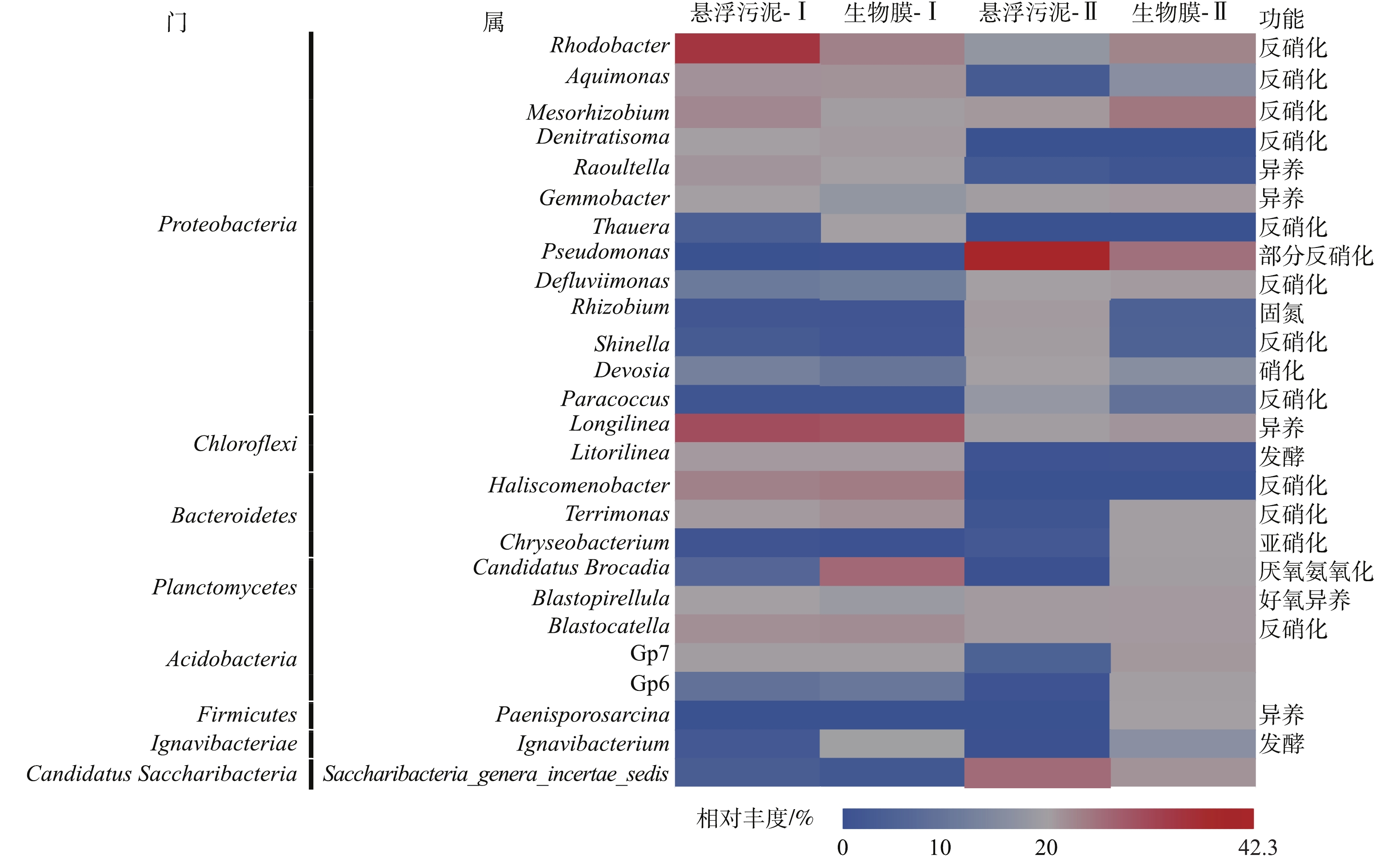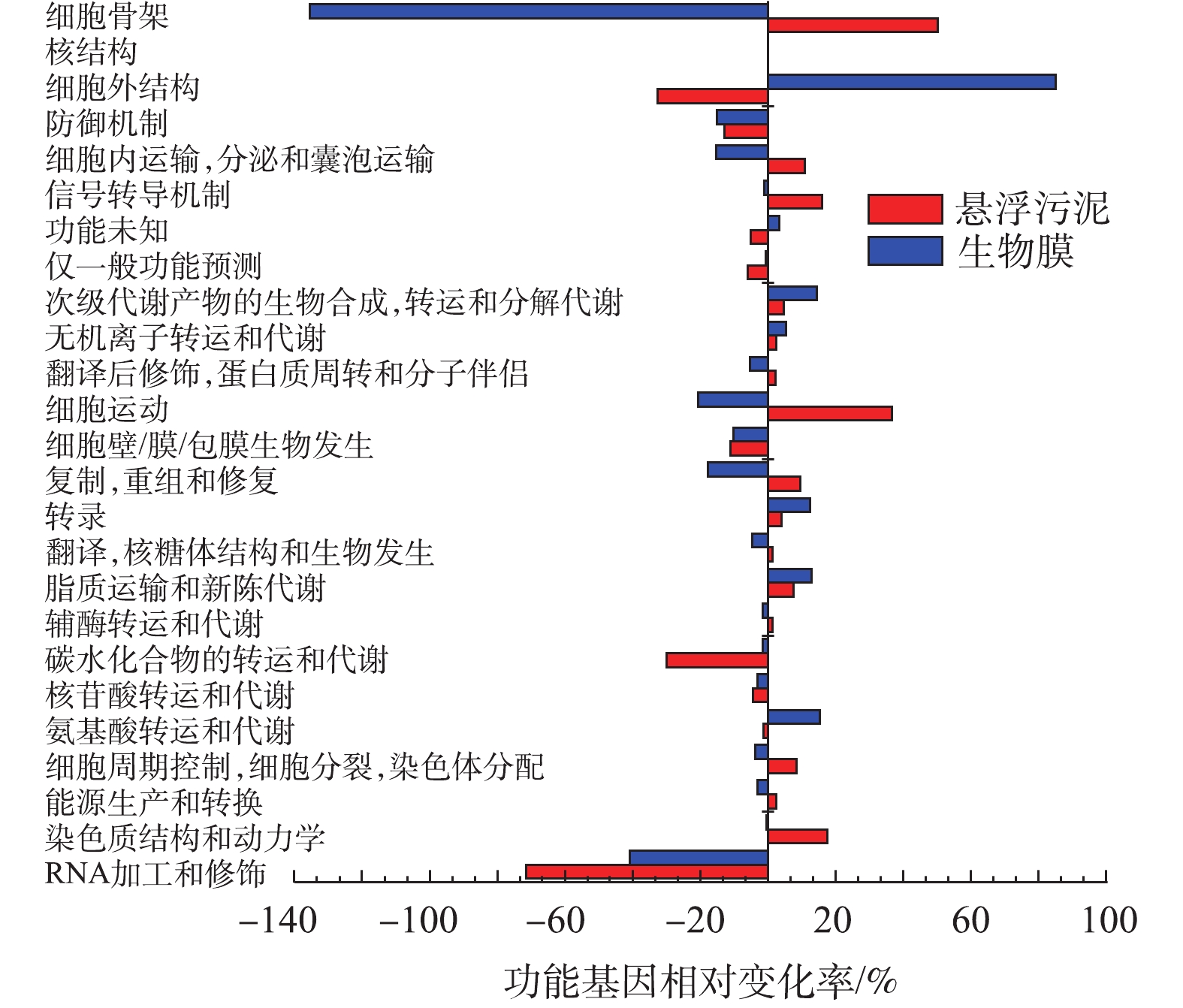2.内蒙古自治区环境污染控制与废物资源化重点实验室,呼和浩特 010021
1.School of Ecology and Environment, Inner Mongolia University, Hohhot 010021, China
2.Inner Mongolia Key Laboratory of Environmental Pollution Control & Waste Resource Reuse, Hohhot 010021, China
)条件下,分别以连续式和间歇式方式运行,采用高通量测序,基于直系同源蛋白簇基因(COGs),对16S rRNA扩增子测序结果进行功能预测,来表征微生物菌群结构和微生物功能的变化。结果表明:系统总氮负荷为(227±13) mg·(L·d)
菌丰度出现明显升高。进一步分析可知,在适量的有机物条件下,间歇式运行能够获得更好的厌氧氨氧化与反硝化协同处理效果。本研究结果可为污水处理厂的实际运行提供参考。
In order to investigate the effect of operation modes on the nitrogen removal performance and microbial community structure of anaerobic ammonia oxidation system, an anaerobic moving bed biofilm reactor was established, which was operated in a continuous flow mode and a batch mode at constant temperature of (25±1) ℃ and low substrate of TN≤60 mg·L
, respectively, used high-throughput sequencing, and based on cluster of orthologous groups of proteins (COGs) gene, 16S rRNA amplicon sequencing results were functionally predicted to characterize microbial flora structure and microbial function changes. The results showed that the nitrogen removal efficiency for the batch mode was 90.6%, which was higher than 74.6% for the continuous operation mode at the total nitrogen load of 227±13 mg·(L·d)
. And the relative abundance of anammox bacteria in biofilm was higher than that in the suspended sludge. When the continuous mode of the reactor changed to batch mode, the abundance of main functional genus
decreased, while the abundance of bacteria with partial denitrification function increased significantly. Through further analysis, the batch mode can obtain better synergistic treatment effect of anammox and denitrification than continuous mode with proper amount of organic matter. The study provides a reference for the actual operation of wastewater treatment plant.
.
Schematic diagram of Anammox system
Denitrification performance of reactors at different operating stages
COD负荷及去除负荷、AMX与DN的氮去除量及其对TN去除的贡献率
COD load and load removal, AMX and DN nitrogen removal and its contribution to TN removal
Taxonomic classification of microbial communities at the phylum level
Heat map of the core genera in the sludge samples in reactor with different operating modes
Prediction of the relative change rate of functional genes
Evaluation of microbial richness and diversity of DNA samples after the change of operation mode
| [1] | XU X C, QIU L Y, WANG C, et al. Achieving mainstream nitrogen and phosphorus removal through simultaneous partial nitrification, anammox, denitrification, and denitrifying phosphorus removal (SNADPR) process in a single-tank integrative reactor[J]. Bioresource Technology, 2019, 284: 80-89. doi: 10.1016/j.biortech.2019.03.109 |
| [2] | MULDER A, VANDEGRAAF A A, ROBERTSON L A, et al. Anaerobic ammonium oxidation discovered in a denitrifying fluidized-bed reactor[J]. FEMS Microbiology Ecology, 1995, 16(3): 177-183. doi: 10.1111/j.1574-6941.1995.tb00281.x |
| [3] | STROUS M, HEIJNEN J J, KUENEN J G, et al. The sequencing batch reactor as a powerful tool for the study of slowly growing anaerobic ammonium-oxidizing microorganisms[J]. Applied Microbiology and Biotechnology, 1998, 50(5): 589-596. doi: 10.1007/s002530051340 |
| [4] | VAN DONGEN U, JETTEN M S, VAN L, et al. the SHARON-Anammox process for treatment of ammonium rich wastewater[J]. Water Science & Technology, 2001, 44(1): 153-160. |
| [5] | SIEGRIST H, SALZGEBER D, EUGSTER J, et al. Anammox brings WWTP closer to energy autarky due to increased biogas production and reduced aeration energy for N-removal[J]. Water Science & Technology, 2008, 57(33): 383-388. |
| [6] | JIN R C, YANG G F, YU J J, et al. The inhibition of the anammox process: A review[J]. Chemical Engineering Science, 2012, 197: 67-79. doi: 10.1016/j.cej.2012.05.014 |
| [7] | LACKNER S, GILBERT E M, VLAEMINCK S E, et al. Full-scale partial nitritation/anammox experiences: An application survey[J]. Water Research, 2014, 55: 292-303. doi: 10.1016/j.watres.2014.02.032 |
| [8] | TANG C J, ZHENG P, WANG C H, et al. Performance of high-loaded ANAMMOX UASB reactors containing granular sludge[J]. Water Research, 2011, 45(1): 135-144. doi: 10.1016/j.watres.2010.08.018 |
| [9] | LIU W R, YANG D H, CHEN W J, et al. High-throughput sequencing-based microbial characterization of size fractionated biomass in an anoxic anammox reactor for low-strength wastewater at low temperatures[J]. Bioresource Technology, 2017, 231: 45-52. doi: 10.1016/j.biortech.2017.01.050 |
| [10] | 凌琪, 曾麒峰, 伍昌年, 等. 不同换水方式在污泥培养驯化中的比较及在倒置A2/O启动研究[J]. 应用化工, 2015, 44: 991-994. |
| [11] | JI J T, PENG Y Z, MAI W K, et al. Achieving advanced nitrogen removal from low C/N wastewater by combining endogenous partial denitrification with anammox in mainstream treatment[J]. Bioresource Technology, 2018, 270: 570-579. doi: 10.1016/j.biortech.2018.08.124 |
| [12] | LI X J, SUN S, YUAN H Y, et al. Mainstream upflow nitritation-anammox system with hybrid anaerobic pretreatment: Long-term performance and microbial community dynamics[J]. Water Research, 2017, 125: 298-308. doi: 10.1016/j.watres.2017.08.048 |
| [13] | DU R, CAO S B, LI B K, et al. Performance and microbial community analysis of a novel DEAMOX based on partial-denitrification and anammox treating ammonia and nitrate wastewaters[J]. Water Research, 2017, 108: 46-56. doi: 10.1016/j.watres.2016.10.051 |
| [14] | LI Q, WANG S P, ZHANG P D, et al. Influence of temperature on an Anammox sequencing batch reactor (SBR) system under lower nitrogen load[J]. Bioresource Technology, 2018, 269: 50-56. doi: 10.1016/j.biortech.2018.08.057 |
| [15] | LI X, LU M Y, QIU Q C, et al. The effect of different denitrification and partial nitrification-Anammox coupling forms on nitrogen removal from mature landfill leachate at the pilot-scale[J]. Bioresource Technology, 2019, 297: 1-9. |
| [16] | ZHENG Z M, HUANG S, BIAN W, et al. Enhanced nitrogen removal of the simultaneous partial nitrification, anammox and denitrification (SNAD) biofilm reactor for treating mainstream wastewater under low dissolved oxygen (DO) concentration[J]. Bioresource Technology, 2019, 283: 213-220. doi: 10.1016/j.biortech.2019.01.148 |
| [17] | DU R, CAO S B, PENG Y Z, et al. Combined partial denitrification (PD)-anammox: A method for high nitrate wastewater treatment[J]. Environment International, 2019, 126: 707-716. doi: 10.1016/j.envint.2019.03.007 |
| [18] | WANG D P, LI T, HUANG K L, et al. Roles and correlations of functional bacteria and genes in the start-up of simultaneous anammox and denitrification system for enhanced nitrogen removal[J]. Science of the Total Environment, 2019, 655: 1355-1363. doi: 10.1016/j.scitotenv.2018.11.321 |
| [19] | KARIM K, HOFFMANN R, KLASSON T, et al. Anaerobic digestion of animal waste: Waste strength versus impact of mixing[J]. Bioresource Technology, 2005, 96: 1771-1781. doi: 10.1016/j.biortech.2005.01.020 |
| [20] | KARIM K, KLASSON T, HOFFMANN R, et al. Anaerobic digestion of animal waste: Effect of mixing[J]. Bioresource Technology, 2005, 96: 1607-1612. doi: 10.1016/j.biortech.2004.12.021 |
| [21] | 刘刈, 王智勇, 孔垂雪, 等. 沼气发酵过程混合搅拌研究进展[J]. 中国沼气, 2009, 27(3): 26-30. doi: 10.3969/j.issn.1000-1166.2009.03.006 |
| [22] | WANG C, LIU S T, XU X C, et al. Achieving mainstream nitrogen removal through simultaneous partial nitrification, anammox and denitrification process in an integrated fixed film activated sludge reactor[J]. Chemosphere, 2018, 203: 457-466. doi: 10.1016/j.chemosphere.2018.04.016 |
| [23] | 袁青彬, 郭美婷, 杨健. 污泥负荷对生物处理系统耐药细菌的影响研究: 以活性污泥法中磺胺嘧啶抗性异养菌为例[J]. 中国环境科学, 2014, 34(8): 1979-1984. |
| [24] | WANG G P, ZHANG D, XU Y, et al. Comparing two start up strategies and the effect of temperature fluctuations on the performance of mainstream anammox reactors[J]. Chemosphere, 2018, 209: 632-639. doi: 10.1016/j.chemosphere.2018.06.134 |
| [25] | GONZALEZ-GIL G, SOUGRAT R, BEHZAD A R, et al. Microbial community composition and ultrastructure of granules from a full scale anammox reactor[J]. Microbial Ecology, 2015, 70(1): 118-131. doi: 10.1007/s00248-014-0546-7 |
| [26] | LEIX C, DREWES J E, KOCH K, et al. The role of residual quantities of suspended sludge on nitrogen removal efficiency in a deammonifying moving bed biofilm reactor[J]. Bioresource Technology, 2016, 219: 212-218. doi: 10.1016/j.biortech.2016.07.134 |
| [27] | WANG S, LIU Y, NIU Q, et al. Nitrogen removal performance and loading capacity of a novel single-stage nitritation-anammox system with syntrophic micro-granules[J]. Bioresource Technology, 2017, 236: 119-128. doi: 10.1016/j.biortech.2017.03.164 |
| [28] | NARITA Y K, ZHANG L, ZENICHIRO K, et al. Enrichment and physiological characterization of an anaerobic ammonium-oxidizing bacterium ‘Candidatus Brocadia sapporoensis’[J]. Systematic and Applied Microbiology, 2017, 40(7): 448-457. doi: 10.1016/j.syapm.2017.07.004 |
| [29] | YANG H, LI D, ZENG H P, et al. Long-term operation and autotrophic nitrogen conversion process analysis in a biofilter that simultaneously removes Fe, Mn and ammonia from low-temperature groundwater[J]. Chemosphere, 2019, 222: 407-414. doi: 10.1016/j.chemosphere.2019.01.143 |
| [30] | KRAGELUND C, THOMSEN T R, MIELCZAREK A T, et al. Eikelboom’s morphotype 0803 in activated sludge belongs to the genus Caldilinea in the phylum Chloroflexi[J]. FEMS Microbiology Ecology, 2011, 76(3): 451-462. doi: 10.1111/j.1574-6941.2011.01065.x |
| [31] | LAURENI M, FAL?S P, ROBIN O, et al. Mainstream partial nitritation and anammox: Long-term process stability and effluent quality at low temperatures[J]. Water Research, 2016, 101: 628-639. doi: 10.1016/j.watres.2016.05.005 |
| [32] | LI S S, PENG C R, CHENG T S, et al. Nitrogen-cycling microbial community functional potential and enzyme activities in cultured biofilms with response to inorganic nitrogen availability[J]. Journal of Environmental Sciences, 2019, 76: 89-99. doi: 10.1016/j.jes.2018.03.029 |
| [33] | WANG S, ZHENG D, WANG S, et al. Remedying acidification and deterioration of aerobic post-treatment of digested effluent by using zero-valent iron[J]. Bioresource Technology, 2018, 247: 477-485. doi: 10.1016/j.biortech.2017.09.078 |
| [34] | KUNDU P, PRAMANIK A, DASGUPTA A, et al. Simultaneous heterotrophic nitrification and aerobic denitrification by Chryseobacterium sp. R31 isolated from abattoir wastewater[J/OL]. [2019-09-10]. BioMed Research International, 2014: 1-12. http://dx.doi.org/10.1155/2014/436056. |
| [35] | DING S, BAO P, WANG B, et al. Long-term stable simultaneous partial nitrification, anammox and denitrification (SNAD) process treating real domestic sewage using suspended activated sludge[J]. Chemical Engineering Journal, 2018, 339: 180-188. doi: 10.1016/j.cej.2018.01.128 |
| [36] | GU Y Q, LI T T, LI H Q, et al. Biofilm formation monitored by confocal laser scanning microscopy during startup of MBBR operated under different intermittent aeration modes[J]. Process Biochemistry, 2018, 74: 132-140. doi: 10.1016/j.procbio.2018.08.032 |
| [37] | WU H, GUO C Y, YIN Z H, et al. Performance and bacterial diversity of biotrickling filters filled with conductive packing material for the treatment of toluene[J]. Bioresource Technology, 2018, 257: 201-209. doi: 10.1016/j.biortech.2018.02.108 |
| [38] | PARK Y, CHO H, YU J, et al. Response of microbial community structure to pre-acclimation strategies in microbial fuel cells for domestic wastewater treatment[J]. Bioresource Technology, 2017, 233: 176-183. doi: 10.1016/j.biortech.2017.02.101 |
| [39] | HAO L P, BIZE A, CONTEAU D, et al. New insights into the key microbial phylotypes of anaerobic sludge digesters under different operational conditions[J]. Water Research, 2016, 102: 158-169. doi: 10.1016/j.watres.2016.06.014 |


 下载:
下载: 




 点击查看大图
点击查看大图